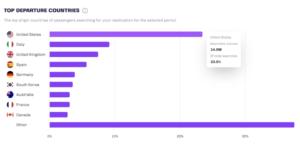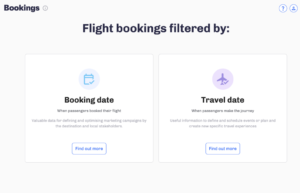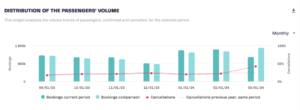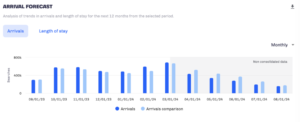Understanding the desires of potential travellers, their flight search patterns, and booking habits is crucial for effective destination management.
Access to data on airfare searches and bookings allows for strategic use in crafting marketing strategies to attract new visitors:
- Enhancing traveller profiling
- Tailoring targeted promotional campaigns
- Gaining insights into preferences and behaviours by country of origin
- Timing marketing activities appropriately for each market
- Providing valuable insights to local operators and stakeholders for tailored offers
- Planning events based on traveller arrivals and origins
However, acquiring and maintaining access to such data, consistently updated and comparable over time, can be challenging.
That’s why D/AI Destinations, Data Appeal’s destination management platform, features a comprehensive flights section for accurate and in-depth analysis of international travel intentions.

WHY IS DATA ABOUT FLIGHT BOOKINGS & SEARCHES USEFUL?
To help you accurately profile your target audience, and their habits and needs, the D/ AI Destinations platform has expanded its Flights Module to the maximum and divided it into 2 sections:
- Flight Searches
- Flight Bookings
Each section is then subdivided by:
- Day of search/booking: When passengers have searched and booked their flight
- Day of travel: When passengers actually want to fly or will fly
Let’s look together at how the module works and how this data is used to optimise marketing campaigns.

WHY DISTINGUISH BETWEEN SEARCH DAY AND TRAVEL DAY?
Analysing data by search day and travel day is useful for planning different marketing actions:
1 – Analysis by day of search or booking a flight helps you decide when to launch your marketing actions.
For instance, if travellers from France are searching for flights to your destination three months in advance, you can strategize your marketing efforts for the summer during May or June.
If Spaniards typically plan their trips mainly one month in advance, your campaigns can start closer to the departure date.
2 – Analysis by travel day helps you plan events or create new experiences and specific travel offerings.
For instance, if your data reveals that Greeks predominantly travel in September, you could develop tailored text and video content targeting this audience, highlighting the most suitable activities for September.
On the other hand, if you observe that your target demographic tends to delay bookings during certain periods of the year, you might consider crafting packages, offers, or incentives specifically tailored for these off-peak months.
Within the flight module, alongside this temporal filter, we offer a diverse array of additional filters for conducting detailed analyses, particularly for marketing purposes:
- By destination city, enabling a focus on relevant airports for your destination
- By country of origin, facilitating the identification of emerging markets or potential opportunities, comprehension of key market segments, and the creation of targeted promotional initiatives
- By type of travel, distinguishing between one-way and return journeys
WHERE DOES FLIGHT SEARCH & BOOKING DATA COME FROM?
Each dataset provides extensive information on flight searches and bookings made through the GDS:
- Total number
- Analysis of arrival forecasts
- Average length of stay by country of origin of passengers
- The most searched routes
- The possible competing destinations for which passengers are searching for flights, filtered by country and city of arrival.
The GDS that provides us with this valuable data is Travelport, which in turn owns Galileo, Worldspan, and Apollo.
As you already know, Global Distribution Systems are large computer systems that connect airlines, hotels, and car rental companies with travel agents.
Travelport aggregates information from 478 airlines (on average 15% more than its competitors).
This offers a precise overview of travel trends and visitor behaviour, especially for international visitors.
COMPARING TODAY’S FORECAST DATA WITH LAST YEAR’S : DATA APPEAL’S SOLUTION
One of the main concern is to have reliable data at hand.
How do you compare the dynamic forecast data that is updated daily with the static data from last year, which has been finalised and consolidated?
Let’s consider a real-world scenario: in January, you can forecast the level of air arrivals for August, but this forecast will evolve from week to week as the date approaches. Hence, comparing today’s forecast with the actual figures from August 2023 may not be appropriate.
That’s why D/AI Destinations has introduced an innovative feature called “rolling views.” This feature enables you to make reliable and accurate comparisons by comparing today’s provisional data with the provisional data from the same period last year.
This method is especially useful for forecasting future trends.
By comparing today’s provisional data with that of the same period last year, you can gain a precise understanding of trends, like bookings on the corresponding date in the previous year.
This ensures a clear and coherent depiction of the evolving situation.



